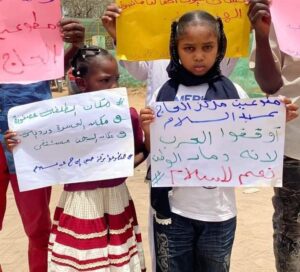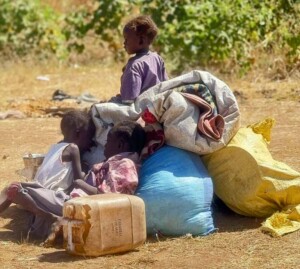UNHCR: Influx of Ethiopian refugees in Sudan ‘unseen’
UNHCR, the United Nations Refugee Agency, calls the crossing of thousands of Ethiopian refugees from the Tigray region to eastern Sudan ‘unseen’. It warns that “a full-scale humanitarian crisis is unfolding”.
 Ethiopian refugees crossing Tekeze River into Sudan at Hamdayet (UNHCR / Hazim Elhag)
Ethiopian refugees crossing Tekeze River into Sudan at Hamdayet (UNHCR / Hazim Elhag)
UNHCR, the United Nations Refugee Agency, calls the crossing of thousands of Ethiopian refugees from the Tigray region to eastern Sudan ‘unseen’. It warns that “a full-scale humanitarian crisis is unfolding”.
Women, men and children have been crossing the border at the rate of 4,000 per day since 10 November, rapidly overwhelming the humanitarian response capacity on the ground, UNHCR reports from its headquarters in Geneva.
More than 27,000 have now crossed into Sudan through the Hamdayet border in Kassala, El Lugdi in El Gedaref, and a new location further south at Aderafi, where Ethiopian refugees started crossing the border over the weekend.
The refugees arrive exhausted from the long trek to safety, with few belongings. UNHCR and its partners are supporting the Sudanese government in its response, ramping up humanitarian assistance at the borders as the needs continue to grow.
In Hamdayet, clean water is being delivered and latrines are being constructed. Soap is provided but UNHCR remains very concerned about the hygiene conditions as more and more people arrive.
At Village 8, the transit centre near El Lugdi crossing, refugees are able to access clean water in nearby communities and use 1,200 existing temporary shelters.
Humanitarian agencies continue to distribute relief items including blankets and sleeping mats. The World Food Programme is providing food and high protein biscuits. Hot meals are provided by Muslim Aid.
The Sudanese Ministry of Health and the Sudan Red Crescent have set up two clinics, and are conducting health and nutrition screenings, medical consultations and referrals.
Since Saturday, UNHCR has so far relocated 2,500 refugees from the border to Um Rakouba settlement site in El Gedaref as renovation works continue. There is a critical need to identify more sites so that refugees can be relocated away from the border and can access assistance and services.
In Tigray itself the lack of electricity, telecommunications and access to fuel and cash continue to severely hamper any humanitarian response. After nearly two weeks of conflict, reports of large numbers of internally displaced people grow daily, while the lack of access to those in need, coupled with the inability to move in goods to the region, remain major impediments to providing assistance. UNHCR and partners are on standby to provide assistance to the displaced in Tigray, when access and security allow.
The conflict is also a major ongoing concern for the Eritrean refugee population of nearly 100,000 in Tigray, who are reliant on assistance from UNHCR and partners.
Deadline
The Ethiopian Prime Minister Abiy Ahmed warned yesterday that a three-day deadline for the surrender of the northern Tigray region's forces has expired, paving the way for a “final attack” on the Tigray’s capital.
The Ethiopian Government Emergency Committee reported yesterday that the Ethiopian National Defence Forces carried out precision air strikes near Mekele, the capital of Tigray.
The Sudanese Ministry of Foreign Affairs announced yesterday that it is “tirelessly attempting to evacuate Sudanese citizens from the Tigray region as soon as possible”. The ministry said that the Sudanese embassy in Addis Ababa is monitoring the conditions of Sudanese nationals in Tigray, despite the interruption of communications in the region.
Radio Dabanga’s editorial independence means that we can continue to provide factual updates about political developments to Sudanese and international actors, educate people about how to avoid outbreaks of infectious diseases, and provide a window to the world for those in all corners of Sudan. Support Radio Dabanga for as little as €2.50, the equivalent of a cup of coffee.












 and then
and then